Chapter Two—
The Instrumental Works
A substantial number of compositions, both instrumental and vocal, survive complete from Schoenberg's Brahmsian period; there are also many fragments and torsos. Because some of the works and most of the fragments were not dated by the composer and are not firmly datable by either internal musical or external biographical means, it is impossible to construct anything like a definitive chronology. But a survey of the surviving juvenilia suggests that it was through his assimilation of Brahms that Schoenberg really began to grow as a composer.[1]
This process started at least as early as 1893, with the first datable Lieder, was well under way with the Piano Pieces of 1894, and culminated in 1897 with two Lieder based on poems by Paul Heyse (to be examined in chapter 3) and the D-Major String Quartet. The principal instrumental compositions of Schoenberg's early period through 1897, not including the smaller fragments, are listed in table 1.[2] In this chapter we trace an ever more sophisticated assimilation of Brahmsian principles across three of the main works, the Piano Pieces of 1894 (and a fragmentary scherzo probably composed at the same time), the Serenade of 1896, and the D-Major Quartet and F-Major Scherzo for Quartet of 1897.
[1] Biographical information on Schoenberg's early years is scarce. Aside from such standard secondary sources as Stuckenschmidt 1978 and valuable but brief memoirs like Zemlinsky 1934 and Bach 1924, Schoenberg's 1949 essay/lecture "My Evolution" (in Schoenberg 1975, 79–92) is the best known and most often cited account of his youth. See also the autobiographical remarks in Schoenberg's 1949 "Notes on the Four String Quartets" (in Rauchhaupt 1971, 35–36).
[2] The most extensive inventory of compositions and fragments from this period is given in Maegaard 1972, 1: 26–28 and 147–66. In compiling his catalogue from materials in the United States (mainly in the Schoenberg Nachlaß in Los Angeles), Maegaard did not have access to the Nachod collection (originally from Schoenberg's brother-in-law Hans Nachod), which is now at North Texas State University and is catalogued in Kimmey 1979. More recently, a small portion of the Nachod collection that had been retained by the last private owners has come into the possession of the Arnold Schoenberg Institute.
| ||||||||||||||||||||||||||||||||||||
The Three Piano Pieces and Scherzo of 1894
As I have suggested elsewhere, a symphony theme cited by Schoenberg as having been written by him in about 1892 already shows a familiarity with Brahms's Tragic Overture specifically, and with Brahms's procedures of thematic evolution more generally (Frisch 1984, 159). Schoenberg's Three Piano Pieces of 1894 (printed complete in SW A4: 73–83), the first substantial instrumental compositions that survive, show that the twenty-year-old composer had continued to study Brahms intensively—in this case, the short piano works published recently in Brahms's collections opp. 116, 117, 118, and 119 (1892–93).
What is striking in the first of Schoenberg's 1894 pieces, an Andantino in





eighth note "early" on the notated downbeat of m. 10. Although notated and perceived downbeats coincide here, the


The last two sixteenth notes of m. 10 hover uneasily in a kind of metrical void: they sound neither like the last beat of a





Schoenberg's complex metrical procedures derive directly from Brahms, who often shifts the entire framework by a beat so that notated and perceived meters are out of phrase for long stretches.[3] But in his almost single-minded concentration on the metrical dimension of the music, Schoenberg tends to leave the others underdeveloped. The harmonic language of the Andantino remains very conventional, as does the basic phrase structure. Despite the metrical blip in mm. 9–11, the whole first section of the piece, up to the double bar, comprises four phrases in

In Schoenberg's Andantino, mm. 1–3 constitute the first statement, beginning and closing on the tonic; mm. 4–6 are the "complementary repetition," beginning on the tonic and moving to III;[4] mm. 7–12, comprising twice as many measures as each of the preceding parts, are the developmental continuation and
[4] In Schoenberg's formulation (1967, 21–24) the second phrase is called the "dominant form," normally beginning on V (his locus classicus is the opening of Beethoven's Piano Sonata in F Minor, op. 2, no. 1). He also acknowledges other possible harmonic schemas, including beginning the second phrase on the tonic and concluding it in a contrasting key.

Example 2.1
Schoenberg, Piano Piece in

conclusion (ending on VI). Schoenberg observes in Fundamentals of Musical Composition that the "development" in the last portion of a sentence usually consists of reducing the thematic material to its smallest components, a process he calls "liquidation" (1967, 58). Liquidation is lacking in the piano piece, however: the basic three-measure unit (in notated measures) remains essentially intact and is given two full presentations in mm. 7–12.[5] What is "developed" is clearly the metrical aspect: the "early" arrival in m. 10 and the mysterious "extra" beat at the end of the same measure constitute the most dramatic changes in the basic unit.
Like many of Brahms's short pieces, and like Reger's Resignation, the Andantino has a ternary form; in this instance the middle section (mm. 13–26) serves as a kind of development of the opening material. As in mm. 7–12, the development is primarily metrical in nature. Indeed, it is the same





Schoenberg varies the return of the opening section in m. 27 (ex. 2. 1): the main theme now appears in canon between the two hands, decorated with an inner part moving in triplets. The canon here serves not purely as a contrapuntal variation of the material, but as further metrical manipulation, which now obscures both the notated and perceived frameworks.
Schoenberg's Andantino, then, can be said to adopt certain outward "symp-
toms" of Brahms's style, evident in the arpeggiated bass and in the piano texture in general, and one more specific technical aspect, that of metrical development. But the piece may be said to founder precisely because the areas of motivic development, harmony, and phrase structure are not treated at the same level as, and are not adequately coordinated with, the metrical procedures (as happens, for example, in the first movement of Brahms's

In these respects the third of the piano pieces, a Presto in A minor, is more ambitious and, it might be said, more successful. In his brief memoir of Schoenberg's youth, David Josef Bach makes the intriguing remark that "with its remarkable rhythm" this piece "already contains the seed of the later Schoenberg" (Bach 1924, 318). Unfortunately, Bach specifies neither what aspect of its rhythm is remarkable nor what prefigures the later Schoenberg. But he is right to imply that the piece is the most advanced of the three.
The progressiveness is not apparent in the phrase structure, which, as in the Andantino, is in itself quite square. The opening eight measures (ex. 2.2a) form what Schoenberg calls a "period" (Schoenberg 1967, 25–31), comprising a fourmeasure phrase and its varied restatement, or what we can call an antecedent and a consequent. (A period generally has two phrases of equal length, unlike a sentence.) In the Presto, both antecedent and consequent end on the dominant; the antecedent begins on the tonic, the consequent on a diminished seventh. The progressive aspect consists of the way this traditional design is filled out with chromatic harmony, specifically with what Schoenberg would later call "vagrant" chords (Schoenberg 1978, 134, 257–67); these are harmonies, such as diminished or half-diminished ones, that are ambiguous and can be led in different directions. Although the tonic is clearly implied by the bass in the first half of m. 1, it is nevertheless obscured by the right-hand arpeggiation of the diminished triad,


Brahms is an obvious source for this kind of controlled, intense chromaticism, as, for example, in the Capriccio, op. 116, no. 3, where the tonic G minor is continually subverted until the end of the A section.[6] The Brahmsian pedigree of the Presto is even more evident in Schoenberg's striving to make the entire tex-
[6] Thieme 1979, 81–82, has pointed to the importance of Brahms's Capriccio, op. 76, no. 1, as a model for the texture and figuration of the middle section of Schoenberg's Presto.
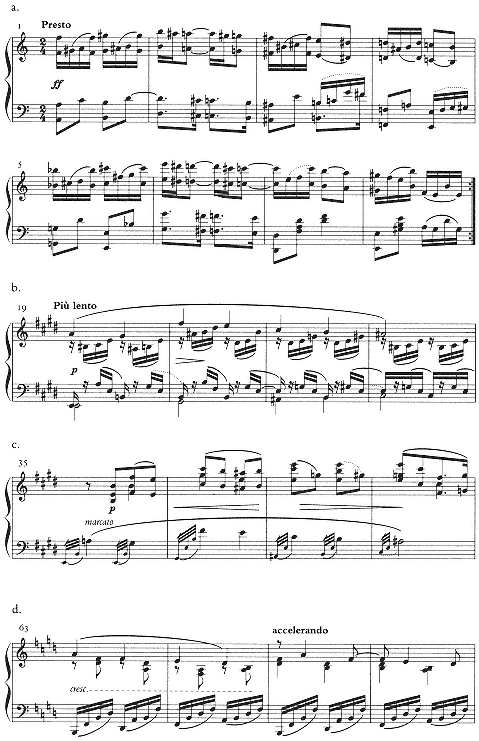
Example 2.2
Schoenberg, Piano Piece in A Minor (1894).

Example 2.2
continued
ture "thematic." The alto inner voice of the B section is derived from the main theme of the A section (ex. 2.2b). Later, the B theme moves into the bass and is presented simultaneously in diminution in the right hand (ex. 2.2c).[7]
The middle section lies in the key of the dominant; but Schoenberg avoids any strong cadential V-i motion at the return to the A. Instead, the return is made via the half-diminished ii7 chord, a vagrant harmony that is sustained for ten measures (mm. 63–72) by means of the energetic working of a descending motive A-F-E-D (ex. 2.2d).[8] The coda (mm. 92–101; ex. 2.2e) is built from the same harmony and motive; the motive is now compressed or diminuted even further and is subject to rhythmic displacement similar to that used in the Andantino in


[7] For the first procedure, see, for example, the first movement of Brahms's Second Symphony, where the arpeggio of the first theme forms (in diminution) the accompanying inner part to the second theme (as mentioned in the previous chapter). For the second, see Brahms's song Mein wundes Herz, op. 59, no. 7, where both voice and accompaniment are derived from the same material.
acts as the transformational beat, and the notated meter returns on the first beat of m. 97. The final cadence to the tonic in mm. 100–101 is made not via the dominant, but from a final appearance of the half-diminished (now in first inversion).
The intensity with which the ii7 chord is manipulated, both motivically and harmonically, suggests something of the later early Schoenberg: in the next chapter we shall see him exploiting the same sonority throughout the song Mädchenfrühling (1897). Yet because the phrase structure tends to remain four-square (even the B section unfolds in rigid four-measure units) and because the melodic invention is less than inspired, our final impression is one of a rather static, undevelopmental form.
A more fluid and sophisticated approach to phrase structure is evident in an eighty-measure fragment in

The first contrasting theme begins with this measure of tonic (not with the preceding dominant) and, like the main theme, consists of two parallel groups of eight measures. The first (mm. 18–25) moves from the tonic to its relative major, A, the second (mm. 25–32) back to the dominant. But these groups overlap, so that the final measure of the first (m. 25) is also the initial measure of the second. The ambiguity is heightened by the initial measure of each phrase (18 and 25), which remains in a sense athematic: the principal motive appears only in the second measure (19 and 26). The result is that m. 18 tends to sound like an introduction and m. 25 like a transition, even though these measures form an integral part of the overall phrase structure.
Thus, although they add up to an even number on the largest scale, the first thirty-two measures of the scherzo do not divide squarely into 8+4, as tends to
[9] See Maegaard 1972, 1: 149. The piece, edited by Reinhold Brinkmann, is published in SW B4:101–4.
happen in the Three Pieces of 1894. Rather, the "extra" measure, m. 17, and the compensating overlapping measure, m. 25, make the internal division asymmetrical:
MAIN THEME
Unit 1: mm. 1–8
Unit 2: mm. 9–16
"Extra" measure: m. 17
FIRST CONTRASTING THEME
Unit 1: mm. 18–25
(Overlapping measure: m. 25)
Unit 2: mm. 25–32[10]
Within the contrasting theme, the motivic working seems more fluid than in the other pieces of 1894. In the first phrase (mm. 18–21), as we have seen, the basic motive appears in the second measure (accompanied by figuration derived from m. 2 of the main theme) and then is rhythmically augmented and transformed across the third and fourth (20–21). In the second phrase the motive appears in the first two measures (22–23), but is absent from the cadential motion of the second two (24–25). The two phrases are thus not simply parallel, as is often the case in the piano pieces of 1894.
Serenade for Small Orchestra (1896)
In 1895 Schoenberg joined the small amateur orchestra Polyhymnia as cellist. It may well have been for this group that he began to compose what appears to be his first large-scale instrumental work, the Serenade in D Major. Schoenberg completed only the first movement; a scherzo, slow movement, and finale survive as fragments. The first movement is dated 1 September 1896 on the first page and 3 September on the last. The scherzo was begun on 30 November. The slow movement and finale bear no date.[11]
[10] By repetition Schoenberg extends the cadence past m. 32; the first theme reappears in m. 38.
[11] The slow movement fragment (microfilm no. U265–67 at the Schoenberg Institute), which bears no date, has not previously been identified as belonging to the Serenade. Maegaard 1972, 1: 26, includes only the other three movements in his entry for the Serenade; the slow movement is described on p. 152 as a separate work. Thieme 1979, 94, also identifies only three movements. Although it is not dated, the Andante clearly belongs to the Serenade. It has the same instrumentation as the other movements. It also has similar handwriting and is copied on the same kind of 28-stave paper as the scherzo movement (the other two movements are on 24-stave paper).
The orchestral serenade was a popular medium within the Austro-German-Bohemian sphere in the last decades of the nineteenth century. Schoenberg would surely have been acquainted not only with the two early serenades of Brahms (opp. 11 and 16), but also with more recent ones by Robert Volkmann, Antonin Dvorak[*] , Josef Suk, and Robert Fuchs. A well-worn score of Fuchs's Serenade for Strings in D Major, op. 9 (published 1874), filled with performance indications in an unidentified hand, survives in the archives of the Schoenberg Institute. This may well have been a score used by Polyhymnia and may also have provided inspiration for Schoenberg's own work in the same key. For his first movement, however, he found a more compelling structural-technical model in Brahms, and in particular in the first movement of Brahms's Second Symphony, also in the key of D major.
The overall design of Schoenberg's movement owes little directly to Brahms; it takes the form of a small-scale and somewhat oddly proportioned sonata, with a very brief exposition (mm. 1–12), consisting of a single long phrase moving from tonic to dominant; a substantial modulatory development (13–44); a conventional recapitulation (45–58); and a lengthy coda (58–77).[12] But the actual thematic ideas and their treatment are strikingly close to Brahms's first movement. Both movements begin with a theme (marked a in ex. 2.3a) in the low strings (violas in Schoenberg, cellos in Brahms) consisting of a neighbor-note figure that surrounds the tonic; the theme falls to the dominant note A. Unlike Brahms, however, Schoenberg accompanies this theme from the outset with a repeated rhythmic figure in the woodwinds (marked b). After two bars (one in Brahms), a new triadic idea (c) enters above motives a and b. This theme is treated imitatively by the violins while being accompanied continuously by the other two ideas. At the climax of the short exposition, the violin theme takes on the rhythm of motive b.
What is especially distinctive here is Schoenberg's creation of a texture in which—as in Brahms—each part is given a motivic or thematic function. The effort is more successful than in the A-minor Presto for piano. Also impressive is Schoenberg's handling of the retransition and arrival of the recapitulation. This is always a crucial moment in Brahms's sonata forms, one for which he developed many elegant and ingenious procedures that Schoenberg must have studied carefully. By m. 33, in the development section, Schoenberg has modulated to


[12] See Thieme 1979, 97, for a formal diagram of the movement, as well as an analysis.
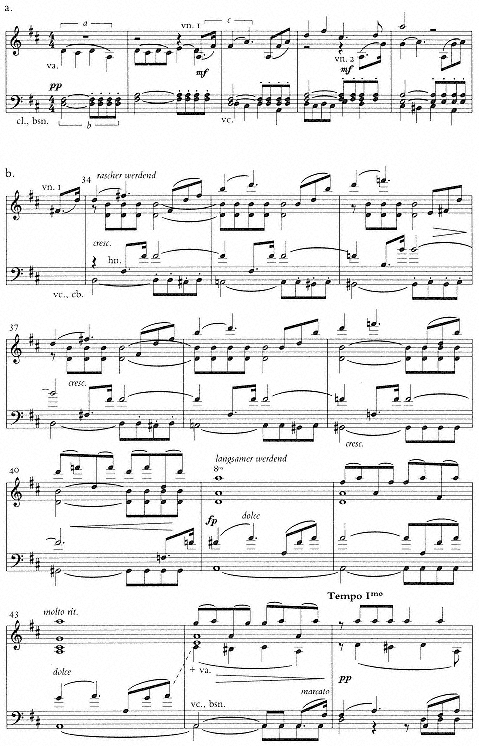
Example 2.3
Schoenberg, Serenade for Small Orchestra (1896), I.

Example 2.3
continued
B, and its chromatic lower neighbor,



The motivic-thematic process complements this harmonic one. For the ten measures preceding the retransition, Schoenberg has avoided developing motive c, which now reemerges at the arrival on B minor, accompanied by motive b in the cellos and basses. At the climax of the crescendo, in m. 40, the theme is dissolved or "liquidated" in diminution—much as Brahms treats his own analogous triadic theme at various points in the first movement of his Second Symphony (cf. mm. 59ff.). Throughout this passage, c has been presented by the strings (first violins and violas), while the horns reiterate only the dotted upbeat figure as a kind of ostinato on octave






The other portion of this movement that deserves commentary is the conclu-
[13] See, for example, the retransition and entrance of the recapitulation in the Andante of Brahms's Third Symphony, discussed in Frisch 1984, 137–40.
sion of the coda, where the tonic is reached not via the dominant, but directly from an augmented sixth chord (a German sixth, spelled






Although the harmonic vocabulary is relatively simple, the association between the two passages, retransition and coda, shows Schoenberg already thinking of harmonic function in terms of large-scale structure. The retransition and coda occupy analogous, or perhaps complementary, places within the sonata form: the retransition represents the moment of greatest harmonic tension, the coda the moment of least tension. To point up the relationship, Schoenberg employs dissonant harmonies that resolve by means of neighbor motion.
In the ways just analyzed, the first movement of the Serenade in D Major is a great step forward from the piano works of 1894. The work is a more effective, persuasive composition largely because Schoenberg has begun to internalize, to make his own, some of Brahms's more important techniques. In terms of the spectrum proposed in chapter 1, we might say that Schoenberg's emulation and allusion are now giving way to absorption. As we listen to the first movement of the serenade, we are less aware of the model than of the skill and naturalness with which Schoenberg manipulates the principles taken over from it.
The D-Major String Quartet and F-Major Scherzo (1897)
Many of the formal, thematic, and harmonic techniques that are beginning to bud in the Serenade in D Major come to fruition in the first large-scale instrumental work that Schoenberg was actually to complete (or allow to survive complete), the D-Major String Quartet. We can be certain that the quartet was revised extensively with Zemlinsky's advice. According to Egon Wellesz—and the information was confirmed by the composer—Schoenberg wrote the work in Vienna in the summer of 1897, then showed it to Zemlinsky upon the latter's return from a holiday. The first and last movements were considerably rewritten, and a new movement was composed in place of the original second one. Apparently at the time he showed Zemlinsky the quartet, Schoenberg had only just begun a third movement (it is not clear whether the fourth was complete); here too an-
other movement was substituted for the planned one.[14] At the instigation of Zemlinsky, the quartet was given a private performance at an evening of the Wiener Tonkünstlerverein on 17 March 1898. The public premiere was given by the Fitzner Quartet at the Bösendorfersaal of the Gesellschaft der Musikfreunde on 20 December of the same year.[15]
For the D-Major Quartet, there exist an autograph and a set of parts (at the Library of Congress), neither of which shows signs of the extensive revisions or substitutions mentioned by Wellesz and Schoenberg. The original second movement survives, however, as a Scherzo in F Major, for which the manuscript is dated 27 July 1897 at the beginning and 7 August 1897 at the end.[16]
Taken together, the D-Major Quartet and the F-Major Scherzo constitute the most successful instrumental works of Schoenberg's Brahmsian period, and as such they bear more extended analysis. The first movement of the quartet was Schoenberg's most expansive sonata form to date. The exposition, which is especially rich in thematic material, has the following shape:
Theme 1a, mm. 1–12
Theme 1b, mm. 13–16
Theme 1a', mm. 17–28
Transition, mm. 29–38
Theme 2a, mm. 39–46
[14] This information about the genesis of the quartet is gleaned from Wellesz 1925, 12–13, supplemented by information that Schoenberg provided Wellesz after the appearance of the latter's book in German in 1921. In the book Wellesz reports that the third movement remained unchanged, but Schoenberg wrote to him that "auch hier kam ein ganz anderer Satz an Stelle des geplanten." Schoenberg's remarks to Wellesz were passed on by Wellesz in 1965 to Oliver Neighbour, who reports them in the preface to Schoenberg 1966. (They also appear in SW B20: XII.) It should be noted that the English translation of Wellesz's biography, first published in 1925, already contained some corrections that Schoenberg had furnished to the author (and that the author had passed on to the translator), although not the information about the third movement of the D-Major Quartet. These other corrections are reported by Carl Dahlhaus in his afterword to a reprint of the German edition of the Wellesz biography (1985, 158–59). I am grateful to Neighbour for providing me with a photocopy of Wellesz's letter to him and for suggestions regarding the genesis of the D-Major Quartet.
[15] See Maegaard 1972, 1: 27–28; Hilmar 1974, 163. See also Zemlinsky 1934, 34.
[16] Published as Schoenberg 1984 and in SW A20. For further information on this scherzo, see also Maegaard 1983. Oliver Neighbour has suggested (personal communication) that a brief sketch contained near the bottom of the scherzo manuscript might have been intended originally as the theme for the third movement. This sketch is reproduced in SW B20: 222; another, much longer version of it is found at the bottom of a leaf containing a fragmentary Heyse setting, Vorfrühling, in the Nachod Collection in Texas (reproduced in Kimmey 1979, 222, item 97; mentioned in SW B1/2/I: 45). Although Neighbour's notion is potentially attractive, it seems unsupported by the theme itself, which is in meter and the key of major. It bears a resemblance to neither the eventual third movement nor the Intermezzo that replaced the Scherzo. This theme seems to demand a relatively rapid tempo (none is actually indicated by Schoenberg) and would thus be unsuitable for a slow movement, which is what we would expect to follow a scherzo.
Theme 2a', mm. 47–54
Theme 2b, mm. 55–64
Theme 2b', mm. 65–78
Theme 2c, mm. 79–86
Codetta, mm. 87–96
This exposition shares with the Serenade in D Major a preoccupation—not to say obsession—with motivic and thematic development. Unlike in the earlier work, however, Schoenberg does not set out three different motivic ideas more or less simultaneously. Instead, the opening theme is presented in unison and octaves by all four instruments, as if Schoenberg wishes to begin as transparently as possible. Example 2.4a shows the first two themes, 1a and 1b, of the tripartite first group. Already in its third measure, theme 1a begins to be "developed": mm. 3–4 form a free but recognizable retrograde of mm. 1–2.
The first twelve measures function as a period, in which mm. 1–4 are an antecedent and mm. 5–12 an expanded consequent that derives quite clearly from what has preceded it. The rhythm of four slurred eighth notes in m. 5 (labeled g ) is developed from the last two beats of m. 3. The rhythmic profile of m. 6 derives from the figure spread across the bar line between mm. 1–2 and 2–3 (x), where the dotted quarter note receives an accent. The consequent phrase explores the implications of that accent by shifting the figure so that it begins on the downbeats of mm. 6 and 8.
In the brief B section of the first group (mm. 13–16), g 'is further modified (hence g '): a rest appears in place of the first note. The pitch content retains the neighbor-note motion of the consequent form (as in mm. 5, 7, and 9), but now shifts it one eighth note to the right, so that in m. 13,

In the first group, Schoenberg saturates the texture within the rhythm and pitch content of g . In the consequent phrase, of the bass presents an inversion (


This developmental process continues past the first group, as is shown in ex. 2.4b, which is the climax of the transition and the beginning of theme 2a. Here motive g forms the beginning of a two-measure idea, of which the second measure is almost a rhythmic retrograde of the first. In the diminuendo and ritar-
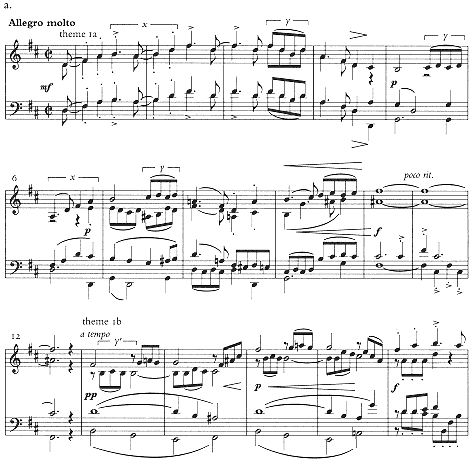
Example 2.4
Schoenberg, String Quartet in D Major (1897), I.
dando of mm. 37–38, the motive is liquidated to a single neighbor-note figure,


If the first group is especially impressive for its motivic concentration, the very broad second group of the first movement is striking for large-scale harmonic control. In this movement (unlike in the D-Major Serenade), Schoenberg avoids the dominant as a second key area, instead orienting the second group around B

Example 2.4
continued
minor and major. The potential importance of the sixth or submediant degree is made apparent at the very opening of the movement: the pitch B is accented in m. 1; a B-minor triad is prominently outlined in mm. 2–3; and the consequent phrase begins in m. 5 with a sustained B in the first violin. At the end of Ia, Schoenberg begins to realize the harmonic implications of these initially melodic details: theme 1a ends with a half-cadence on

The second group of the exposition returns to, and remains in, the key of the submediant. What is most remarkable—and bears some scrutiny here—is how Schoenberg manages to sustain harmonic tension across the very broad, fifty-six-measure expanse of the second group. Theme 2a begins over a dominant pedal (








supports a German sixth chord in a distinctive third inversion. When this process is repeated sequentially up a minor third in m. 59, we are brought back to

All this chromatic activity and sequential motion makes 2b more of a transitional than a "thematic" section. Theme 2b' now serves to stabilize and, as it were, thematicize this material. Like 2a, however, this theme begins over a dominant pedal and touches down only fleetingly on the tonic B. At its climax this theme moves to V/V,



The various harmonic diversions and the constant return to an



As a whole, then, the first movement of the D-Major Quartet shows an impressive grasp of principles associated most closely, or most immediately, with the music of Brahms. By comparison, the possible influence of Dvorak[*] on this work seems insignificant. To be sure, as Reinhard Gerlach has noted, the outer movements of the quartet have a strongly Slavic flavor (Gerlach 1972, 124). He points especially to Dvorak's[*] F-Major Quartet, op. 96 (1894), which opens with a pentatonic-style theme not unlike Schoenberg's. But the resemblance is only superficial, for in the D-Major Quartet the emphasis on the sixth degree is not merely a local effect: as we have seen, Schoenberg goes on to build important structural features of the movement from the submediant degree. In its diatonic

Example 2.5
Schoenberg, String Quartet in D Major (1897), I.
form as




Moreover, Schoenberg need not have looked to Dvorak[*] for a pentatonic melody; one still more similar to his own, and in the same key as his quartet, can be found in Brahms's op. 71, no. 1, the song Es liebt sich so lieblich im Lenze! (1877). Brahms's vocal melody (ex. 2.6) is in fact shaped very much like Schoenberg's
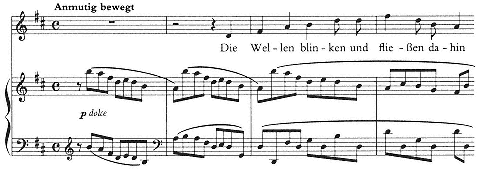
Example 2.6
Brahms, Es liebt sich so lieblich im Lenze! op. 71, no. 1.
theme, forming a broad triadic arch with the


What keeps the first movement of the D-Major Quarter rather earthbound, however, despite its motivic and harmonic elegance, is the four-square nature of its phrase structure and rhythmic-metrical language. Virtually every theme or section unfolds in four- or eight-measure units. The original second movement of the quartet, the F-Major Scherzo, shows greater flexibility in this regard, and (on a smaller scale) is equally accomplished in its motivic, formal, and harmonic aspects.
The main theme of the scherzo, presented by the viola (ex. 2.7), is one of the most economical and concentrated—and in these respects, prophetic—in all of early Schoenberg. The five-measure antecedent consists of malleable two-note motivic units (marked by brackets in the example) that take on various rhythmic and metrical shapes. In the first measure the unit begins on the downbeat with a quarter note. The initial note is then reduced to an eighth and placed in a weak metrical position as the upbeat to m. 2; this pattern is twice repeated within (and across) mm. 2–3. Schoenberg's manuscript fails to provide a slur from the upbeat in m. 3 to the downbeat of m. 4, but our ears can still trace the two further modifications of the two-note unit leading up to the cadence on F on the last beat of m. 4.
The treatment of the unit in mm. 2–3 implies (in the viola part only) a hemiola—a broad measure of


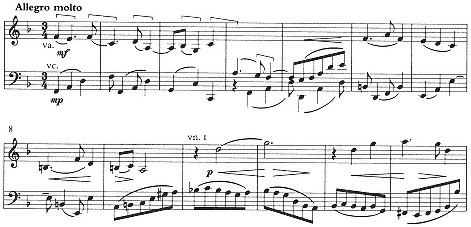
Example 2.7
Schoenberg, Scherzo in F Major for String Quartet (1897).
effect is distinctive here because the hemiola extends across the two interior measures of a four-measure phrase. Even in Brahms, the ostensible model for the device, a hemiola will usually begin on a strong bar (as in m. 25 of the third movement of the

In the consequent phrase (mm. 6–9), Schoenberg expands the basic motivic unit to three notes, which now remain comfortably within the bar line as the music takes on a more lyrical regularity. The cadence on iii, or A minor, leads to a new thematic idea in the first violin (m. 10). This new idea, an ascending fourth, is presented initially as a two-note unit, a free but conspicuous augmentation of the opening rhythmic shape. This motive is now answered by a phrase in which the two-note ascending fourth, in rhythmic diminution, becomes the first component of a figure that rises to A, then sinks back through G to the starting point, D.
Two aspects of this process are of particular interest. First, as in theme 1a of the first movement of the D-Major Quartet, Schoenberg shows a predilection for palindromic or retrogradable themes (D-G-A-G-D). Of greater significance is the way the five-note thematic figure of mm. 12–13 synthesizes the two rhythmic elements of the first theme: the two-note unit is now joined with, and completed by, a three-note one. That the A-G-D component is a three-note unit, despite the slur that covers all five notes in mm. 12–13, is confirmed by the independent appearance of the motive in mm. 20–21.
The motivic-rhythmic process traced here across the first part of the scherzo
equals in fluidity that of the first movements of the serenade and quartet. The same might be said of the elegant recapitulation within the scherzo proper (Appendix ex. C). The recapitulation enters over a dominant pedal, but it is the dominant of D, not F. The retransition has been governed by an intense E pedal, which pushes toward a resolution on A. When the A arrives in the bass in m. 88, after a dramatic one-beat Generalpause, it supports neither an A-major chord (the expected resolution) nor a first-inversion chord on the true tonic, F (which might have provided a clever way to introduce the tonic), but a D-major

In its turn, the A also proves deceptive. Instead of resolving to D, it moves up to





The entire recapitulation, then, shows a control of form, harmony, and voiceleading so impressive that we can only wonder why Zemlinsky advised Schoenberg to replace the scherzo. Perhaps the suggestion had more to do with Stimmung than with compositional technique: Zemlinsky may have felt that a relatively bumptious scherzo was no longer appropriate in chamber music at the fin de siecle. In his own works of this period, Zemlinsky tended either to substitute for the scherzo a more gentle allegretto in the manner of Brahms (the String Quartet, op.4) or to eliminate the scherzoaltogether (the Clarinet Trio, op.3, which has only one inner movement, a slow one). In the D-Major Quartet, Schoenberg decided on the former route: the second movement became a lilting Intermezzo in

The F-Major Scherzo and the Intermezzo that replaced it have in common the use of the viola as the principal melodic voice, a feature that seems to derive most directly from the third movement of Brahms's


Example 2.8
Brahms, String Quartet No.3. in


Example 2.9
Schoenberg, String Quartet in D Major (1897), III.
Brahms's first and second violins in mm. 7–8 as one of the principal accompanimental motives, which appears in the second violin, in mm. 1, 3, etc.) By comparison, the newer intermezzo seems tame. Schoenberg takes over the Klangfarbe of the Brahms (muted strings) with some elegance, but he loses the motivicrhythmic élan.
In suggesting that the scherzo be replaced, Zemlinsky may have felt that it was too close in general style and specific motivic content to Brahms's op. 67. If so, he failed to see (or hear) past the symptoms, to see how flexibly and creatively Schoenberg had reinterpreted Brahms's compositional techniques. To be sure, the new Intermezzo gave Schoenberg's quartet a more symmetrical, and unusual, tonal plan: across the four movements, the keys rise by major third,

the original third movement was retained when that movement was replaced by the present one.
In his brief reminiscences of Schoenberg, Zemlinsky remarks that although much of the D-Major Quartet was derivative from Brahms, "a middle movement already strikes an individual tone" (Zemlinsky 1934, 34). Recent commentators have assumed that by "middle," Zemlinsky meant the new second movement, the Intermezzo, whose composition he apparently encouraged (Gerlach 1972, 125; Thieme 1979, 113). But I suspect he intended the third, which in many respects is the most innovative and impressive of the five movements that survive.
The gnomic eight-measure theme (ex. 2.9) is, to my knowledge, unique in the variation literature in that the first half is played unaccompanied and the second half consists of two lines in counterpoint. (The texture and procedure are very different from baroque variations on a ground, and bear only a distant relationship to the finale of Beethoven's Eroica, where the "theme" is at first a single line, which is then joined by a counterpoint in the first variation.) There are two basic rhythmic motives, which are developed to some extent independently of intervallic concerns: the two-note figure of m.1 (x) and the more extended four-note figure of m.2 (y), which can also be heard as a combination of two two-note motives. Rhythm y, which serves to conclude both the antecedent and consequent of the first half of the theme, initiates the second half (mm. 5–6).
The two phrases of the first half are well balanced intervallically: the descending third of the antecedent (





Because of the sparse texture of the theme, the slightest chromatic detail seems to take on special significance. The emphasis on






One other aspect of the theme deserves particular mention: the emphasis on imitation in the antecedent of the second half, where the cello follows the viola in a rhythmic canon at the distance of a quarter note. The principle of imitation will prove important in the following variations, as will the particular relationship between the parts at this point in the theme.
The autograph score of this movement contains seven variations (five in minor, two in major) and a coda. Schoenberg indicated two of the variations for deletion, those between the present 3and 4 (in minor), and 4 and 5 (in major).[17] Throughout the variations, Schoenberg makes good, as it were, on the polyphonic-contrapuntal implications of the theme. The idea of canonic imitation proposed in the antecedent of the second half is taken up and developed in different ways—and at different moments—in each variation. In variation i, the two-note groups of the theme (the first violin) are imitated two beats later by the two-note groups in the cello. A similar but modified relationship exists in the varied repetition of the first part of variation 2 (mm. 21ff.), where the violin begins the two-note group on the upbeat, the cello on the downbeat. In the second half of the variation, all three upper instruments engage in imitation (mm. 25–26). In the first two measures of variation 3, the first violin and cello are in free rhythmic imitation; in the second half, Schoenberg intensifies the imitation at the place analogous to the preceding variation: all four instruments now participate. In variation 4, the violin and cello are again in rhythmic imitation, now at the close distance of a sixteenth note. In variation 5, the second violin and viola are in imitation.
Another significant feature of the variations is the way Schoenberg treats the rhythmic motive y at the beginning of the second half. From variation 1 on, the originally subordinate imitative voice begins to take on a motivic life of its own (let's call it z). In variation 1 (m. 13), y appears in the second violin; it is imitated, less strictly than before, in the viola and cello (z), where the first note is now shortened from a quarter to an eighth and the pitch contour is altered (ex.2. ioa). In the analogous spot in variation 2 (ex. 2.1ob), y is varied with continuous eighth notes, and treated imitatively by the second violin, first violin, and viola (mm. 25–26). Motive z has now completely shed its imitative role: in the viola and cello, it remains in the rhythmic form it assumed in the preceding variation (with the opening leaps inverted). Similarly, in variation 3 (ex. 2.1oc), a further diminution of motive y is treated imitatively independent of motive z, which appears in the first and second violins (m. 33).
Motive z is absent in variation 4 and in the two rejected variations, but receives its apotheosis, so to speak, in the final variation, variation 5 (ex. 2.1od). Here it changes position within the variation structure, appearing at the very opening (m. 63) instead of at the beginning of the second half. It thus stands in place of the expected two-note motive, x. Furthermore, z now generates its own imita-
[17] The two rejected variations appear in both Schoenberg 1966 and SW B20: 276–78. In the former, they are placed in the score in their original positions and are marked, respectively, A and B. In the latter, the rejected variations, printed only in the critical report, are called IV and VI. To avoid possible confusion with Roman numerals indicating harmonic function, I here adopt the A and B labels for the two variations, as well as the measure numbering of Schoenberg 1966.
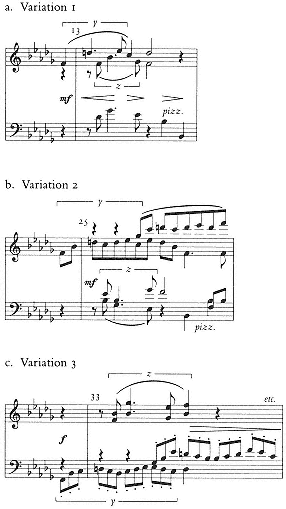
Example 2.10
Schoenberg, String Quartet in D Major (1897), III.
tion,between second violin and viola. At the opening of the second half of the theme—the customary position for z —Schoenberg retains only a small hint of the motive in the syncopated rhythm that begins in the viola (m. 70) and moves into the second violin (ex. 2.1oe).
The evolution undergone by z helps to give the entire variation structure a coherent shape. (Perhaps this is one reason Schoenberg deleted two of the variations, A and B, that bore no trace of z and thus did not contribute to the overall
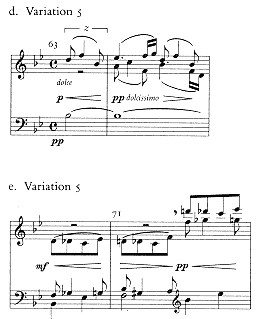
Example 2.10
continued
shape.) So too does Schoenberg's treatment of harmony. The initial harmonic structure of the theme is adhered to closely in variations 1 to 3. In each, as in the theme, the antecedent of the first half moves to V, the consequent back to i; the antecedent of the second half begins in the tonic major and moves to VI; the consequent returns to the tonic. This design is changed significantly for the first time in variation 4, where the second half begins directly in





The annexation, or integration, of these altered scale degrees is carried still further in the two major variations, B and 5. Instead of returning to I, the first half of variation B moves to III, or Dmajor, the key approached so forcibly in the preceding variation (4). The choice of key is significant in another respect: D, lying a major third above the tonic, serves as the symmetrical counterpart to the


The slow variation 5 is the first in which Schoenberg actually expands the original phrase structure: each half of the theme now lasts eight measures instead of four. In this way Schoenberg creates the temporal space, as it were, in which to synthesize important features of preceding variations. (We have already noted the "apotheosis" of motive z.) As in variation B, the second of the rejected variations, the harmony moves first to V, then to III, but now the pattern changes. In the second half, Schoenberg returns to the tonic relatively soon (mm. 72–73), but then, after a notated Luftpause, shifts abruptly to





With this elegant passage, Schoenberg has reintegrated into the major mode the


The final variation is a remarkable testimony to the young Schoenberg's powers of synthesis and long-range planning. And the variation movement as a whole stands as his finest achievement within the Brahms chamber music tradition. The D-Major Quartet is, in fact, Schoenberg's last work that falls directly within that tradition. Between the composition of the quartet in the summer and fall of 1897 and the composition of the sextet Verklärte Nacht almost exactly two years later, he was not to complete another piece of instrumental music. Any link between the two works seems to have been forged not in the realm of instrumental music, but in that of Lieder.